| |
The following items are available to sponsor within the price bracket of £200 to £300.
To sponsor one of these items, please contact the Alumni Officer:
Email: alumni@christs.cam.ac.uk
Telephone: 01223 761769 or 766710
Postal address: The Development Office, Christ's College, St Andrew's Street, Cambridge, CB2 3BU, UK.
Samuel Dugard, The Marriages of Cousin Germans (1673)
Ref. SB17-18/1
Cost: £210

“Cousin German” is a Middle English term designating what nowadays we would call first cousins. Samuel Dugard (?1645-1697), may have written this book specifically in response to a 1649 text by Bishop Joseph Hall of Norwich (1574-1656) that used scripture to rule against the practice of cousins marrying. A Fellow of Trinity College from 1667, Dugard had reason to take a personal interest in the matter, because in 1672 he himself married his cousin Lydia and, upon her death in 1675, married another of his cousins, Elizabeth.
Our copy, donated by former Christ’s College Fellow the Rev. Alfred Valentine-Richards (1866-1933), also includes two other works on the same subject, both by John Turner, a Christ’s Fellow from 1673-81. Like Bishop Hall’s text, these are also critical of the practice of marriage between cousins.
Our copy has a detached front board and a split at the top of the back joint. Both will need to be repaired and some surface cleaning performed.
Shelfmark: Christ’s College, C.15.21
Nicholas of Lyra, Praeceptorium Divinae Legis (1496-8)
Ref. SB17-18/2
SPONSORED!
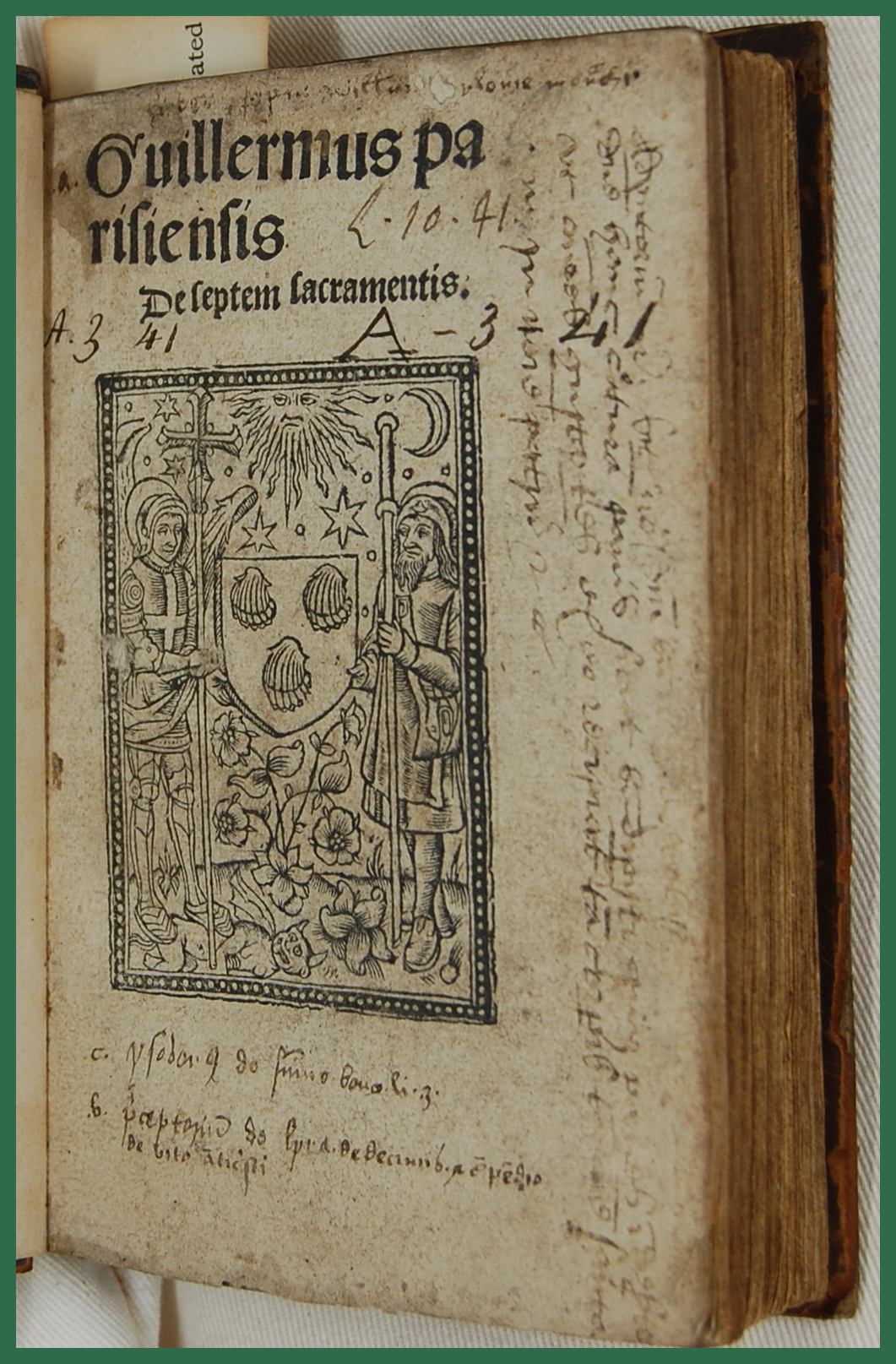
This unique book is composed of three separate titles, all printed in the late 1490s. The first is Dialogue on the Seven Sacraments by Guillaume de Baufet, Bishop of Paris from 1304 to 1319; our copy is the only one in England and one of 12 in the world. The third work is De Summo Bono by Isidore of Seville, Bishop of Seville (600/601-636); our copy is one of 11 in the world. The second title, Praeceptorium, notes on the first page of the text that it was written by Nicholas of Lyra (1270-1349), a Franciscan monk from Normandy, but more recent scholarship attributes it to Henry of Friemar (c.1285-1354), an Augustinian monk from Thuringia.
Our copy is one of only 8 in the world. In addition to being rare, each text was annotated by 16th-century scholars. The back of the title-page of the first text even records a last will and testament. Sponsorship would allow for gentle surface cleaning and repair to the binding.
Shelfmark: Christ’s College, Inc. 2.24
A Book of Tracts (17th century)
Ref. SB17-18/3
Cost: £230
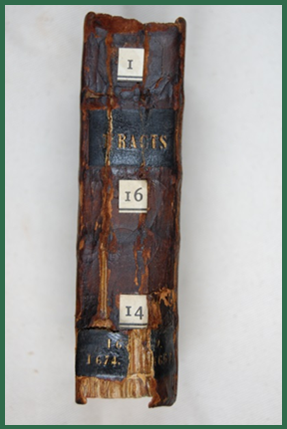
Two of the three tracts in this fragile volume comprise important medical treatises. The first is Marcello Malpighi’s (1628-94) De Viscerum Structura Exercitatio Anatomica, published in 1669 and dealing mainly with the liver, kidneys, and brain; the second is the De Statica Medicina of another famous Italian physician from an earlier time, Santorio Santorio of Venice (1561-1636). The third tract is by Sir William Petty (1623-87), member of the Royal Society and friend of Samuel Pepys (1633-1703); it covers a variety of scientific (but not medical) topics, including philosophies relating to matter and motion, which, the author claims, “a child of 12 years old may learn in an hour”.
Unfortunately we cannot know who brought these three tracts together, and when. However, the volume is listed in the Library’s handwritten catalogue of 1736, so was clearly in our collection by that time.The book is in its original cheap binding, with paper covers and thin leather back-strip, which has split and requires repair. Surface cleaning is also needed.
Shelfmark: Christ’s College, I.16.14
David van Goorle, Idea Physicae (1651)
Ref. SB17-18/4
Cost: £230
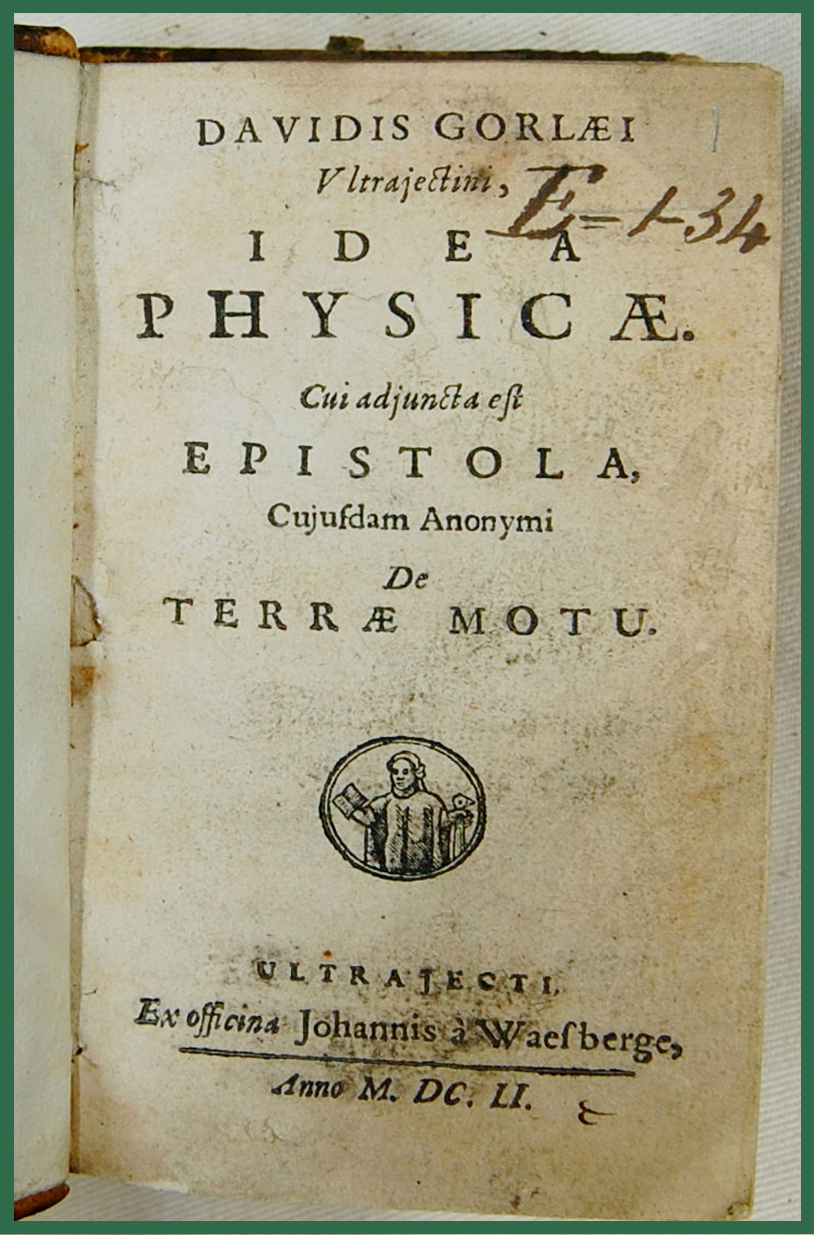
Despite the fact that David van Goorle (1591-1612) died aged 21, his two works (both published posthumously), Exercitationes Philosophicae (1620) and Idea Physicae (1651) were profoundly influential on the evolution of chemistry. In Idea Physicae, van Goorle disputed Aristotle’s widely-held claim that all matter was made from the four elements: Earth, Fire, Water, and Air. Van Goorle’s anti-Aristotelian theory led him to be considered one of the first modern atomists.
Idea Physicae did not enjoy wide circulation and this first edition is especially rare. It is bound with two short works by other authors on notably divergent topics: A Character of England (1659) and The Advice of Charles the Fifth to his Son (1670). The spine is badly damaged and requires considerable consolidation. The text block is also in need of surface cleaning and small paper repairs.
Shelfmark: Christ’s College, I.16.18
Lucan, M. Annaei Lucani Pharsalia, sive De Bello Civili Caesaris et Pompeii Lib. X. (1672)
Ref. SB17-18/5
Cost: £230
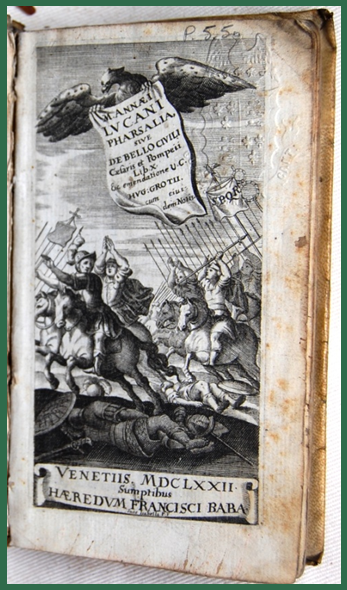
Lucan (39-65AD) was a Roman poet active in the reign of Emperor Nero (37-68AD). He began composing De Bello Civili (also known as the Pharsalia) around 61AD but it was left unfinished upon his death 4 years later. Lucan was compelled to commit suicide after Nero sought retribution for Lucan’s involvement with the Pisonian conspiracy.
This noteworthy 17th-century edition of Book Ten of De Bello Civili (1672), edited by the renowned philosopher and political theorist Hugo Grotius (1583-1645), features a detailed engraved title-page depicting a vicious battle between Julius Caesar (100-44BC) and the forces of the Roman Senate led by Pompey the Great (106-48BC). Sponsorship would allow for repairs to the top of the spine, surface cleaning, and a protective phase box. There are signs of degradation (and rodent damage!) to the pages, which will require extensive Japanese tissue repairs.
Shelfmark: Christ’s College, P.5.50
Kenelm Digby, Choice and Experimented Receipts in Physick (1675)
Ref. SB17-18/6
Cost: £230
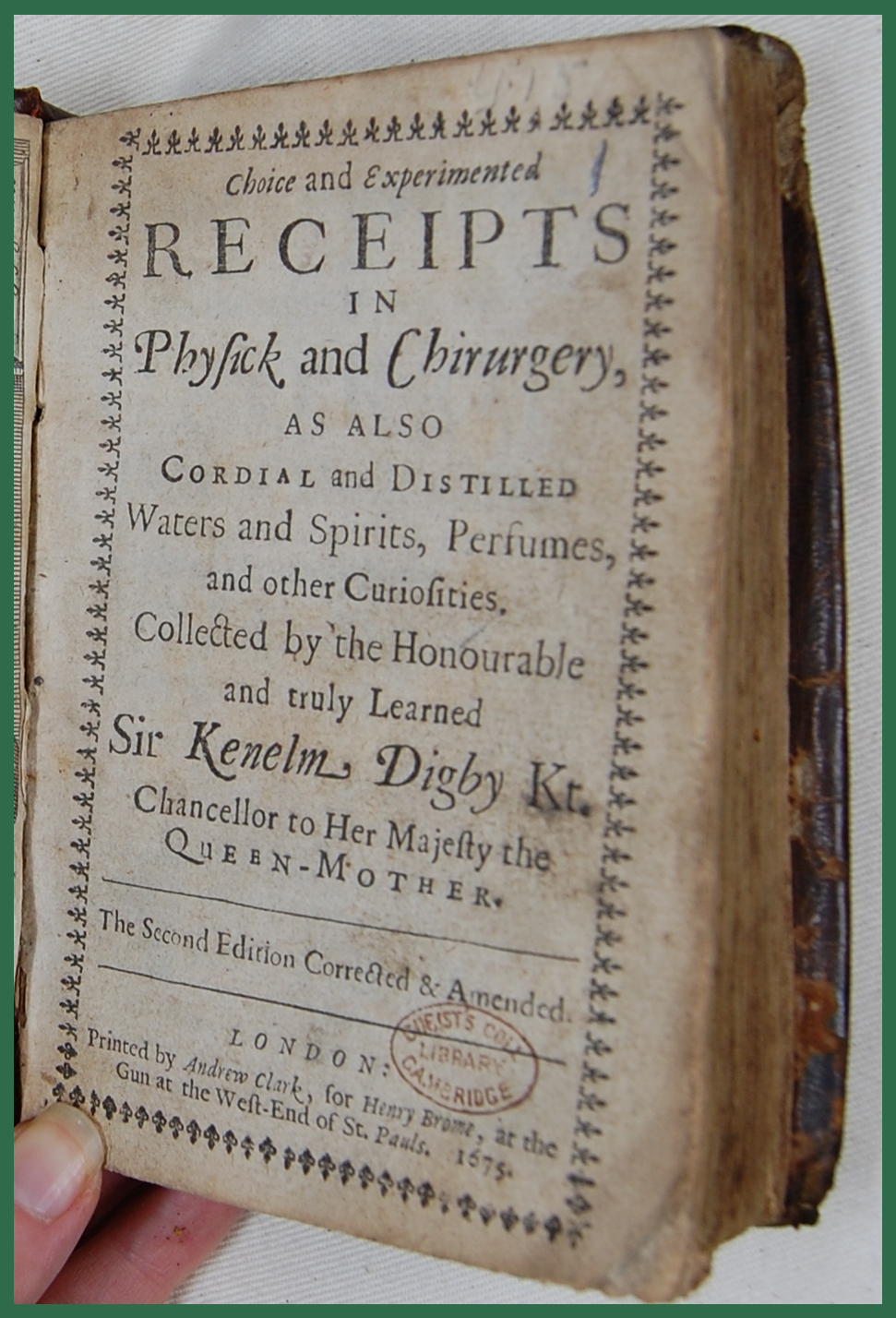
Choice and Experimented Receipts is a fascinating example of a medical ‘receipt’ or recipe book. Such manuals of domestic medicine were an extremely popular genre in the early modern period, at a time when the majority of medical care was administered at home. Diverse treatments are offered: from “Wounds or Sores in Man or Beast” cured with “Hog’s grease” to a “cordial water of sweet marjoram” for the “head and the memory”.
Sir Kenelm Digby (1603-65) was a voracious collector of books and manuscripts from all over Europe. Many of Digby’s receipts name-drop eminent contacts but others are more clearly a result of his own experimentation. Though worn through use, the binding of this charming volume requires minimal intervention. However, surface cleaning and paper repairs are needed to stabilise the text block for future consultation and display.
Shelfmark: Christ’s College, Rouse 9.8
Barnabe Googe (translator), Foure bookes of husbandry (London, 1601)
Ref. SB17-18/7
Cost: £240

Poet, translator and Christ’s-man Barnabe Googe (1540-94) never completed his studies, perhaps due to an outbreak of plague in 1556, a year after he came up to Cambridge. He did, however, go on to serve on the fringes of court under William Cecil (1520/21-98) and gained a significant reputation as a translator, as well as a poet in his own right.
This charming item is Googe’s second-most popular work. A translation of Conrad Heresbach’s (1496-1576) practical guide to “the whole art and trade of Husbandry, Gardening, and Planting, with antiquitie, and commendation thereof”, the handbook promises advice on everything from “Bees what angreth them” to “Bullocks bitten with a mad dogge”.
This copy of Foure books of husbandry is remarkable for being owned by the great agricultural reformer Arthur Young (1741-1820), and contains a translation of Virgil’s Georgics that Googe was highly commended for at the time. Sponsorship would allow the top panel of the spine to be repaired with aerolinen and the front board to be properly supported. The text block also requires careful surface cleaning.
Shelfmark: Christ’s College, CC.4.18
René Rapin, Reflections Upon the Use of the Eloquence of these Times (1672)
Ref. SB17-18/8
Cost: £270
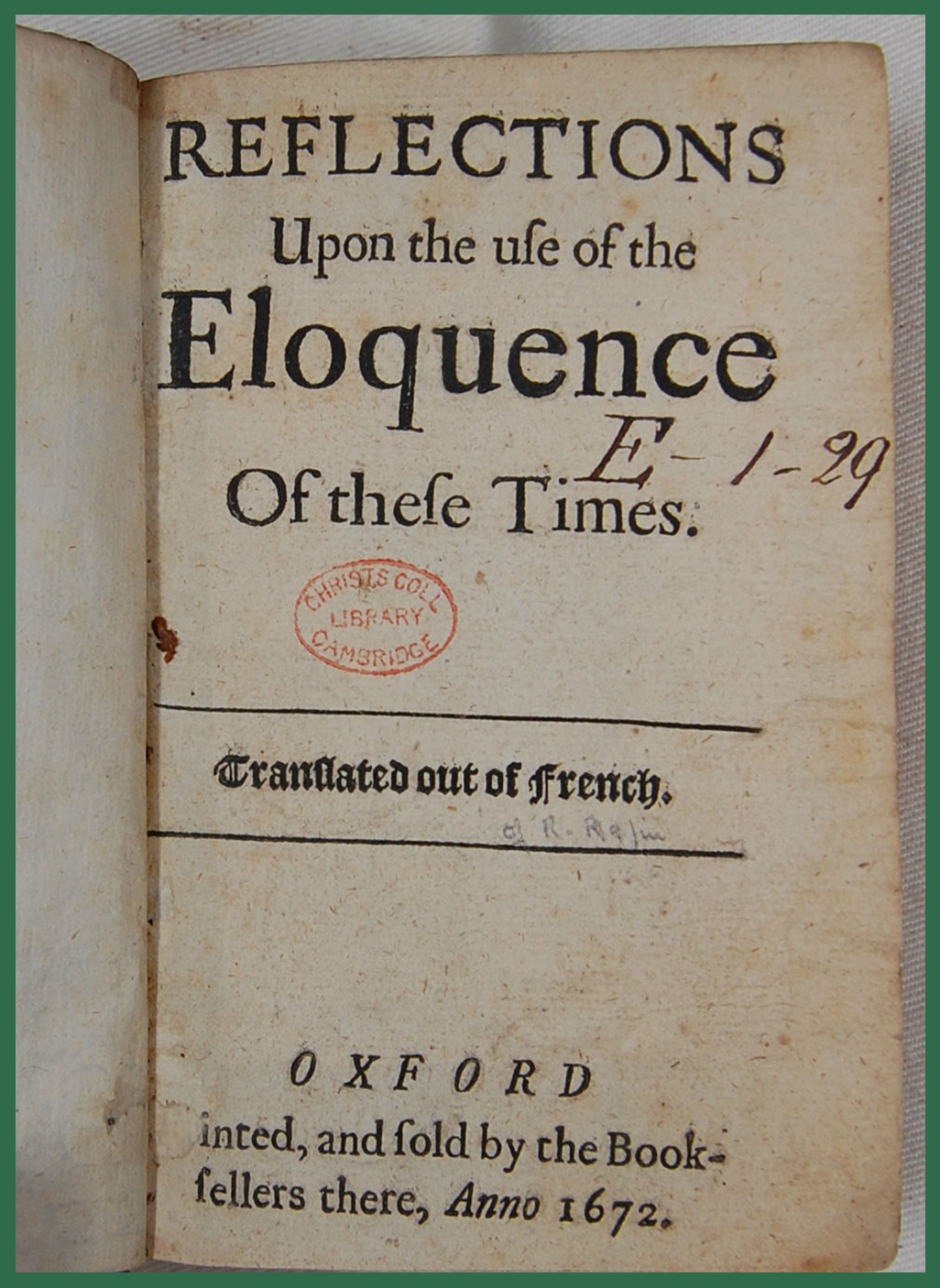
“Although the power of true Eloquence be more absolute than either that of authority or violence...this very power is subject to revolutions and decays,” laments René Rapin (1621-87) in this first translated edition of his influential work. Rapin, a French Jesuit priest, poet, and critic, sought to promote the “master-pieces of discourse” associated with classical Athens and Rome to his contemporaries: a generation that possessed, he rather sourly stated, “nothing but a vain shadow of eloquence.” Rapin’s advocacy of fluent oratory was a dominant influence on late 17th-century French cultural life and shaped 18th-century English neo-classicism.Our copy of Reflection Upon the Use of Eloquence has suffered significant damage to its spine and requires careful repair with Japanese tissue to consolidate the joints of its front and back boards.
Shelfmark: Christ’s College, I.16.7
Laurence Echard, A Most Compleat Compendium of Geography (1691)
Ref. SB17-18/9
Cost: £280

Christ’s College alumnus Laurence Echard (1670?-1730) was a renowned historian who produced numerous works on history, geography, and the classics. He wrote A Most Compleat Compendium of Geography during his first year at Christ’s (1691), a remarkable feat for a twenty-year-old. Echard claimed that he was encouraged to produce this compendium by mathematician and natural philosopher, Sir Isaac Newton (1642-1727).The compendium went through two editions in its first year, indicating its popularity, and went through at least eight editions in total.
Our copy of the second, augmented edition of 1691 features detailed maps of Europe and Asia. Echard dedicated this work to the Master of Christ’s College at the time, Dr John Covel (1638-1722).Sponsorship of this item would allow the front and back boards to be reattached and repairs made to the head and tail caps.
Shelfmark: Christ’s College, C.12.1
Joachim of Fiore, Vaticinia, siue Prophetiae Abbatis Ioachimi & Anselmi Episcopi Marsicani (1589)
Ref. SB17-18/10
Cost: £280

Printed in Venice in 1589, this bilingual (Latin and Italian) volume contains a series of prophecies relating to future Popes, attributed to the late 12th-century Italian monk Joachim of Fiore. While this attribution is incorrect, the text was remarkably popular, both in manuscript and printed forms. Its presence in an English collection is unusual.
By 1589, England was firmly Protestant and had weathered several Catholic plots against Queen Elizabeth. Most Catholic believers considered the prognostications of this book to be true, so perhaps it was acquired by a Protestant who wished to mock the beliefs of Catholics on the Continent. Alternatively, the charming and sometimes bizarre illustrations may have intrigued purchasers.
Sponsorship would allow for gentle surface cleaning of stains and for repairs to the binding.
Shelfmark: Christ's College, D.12.21
|
|